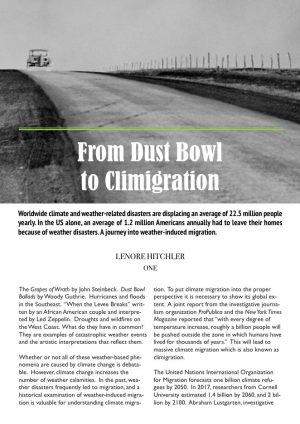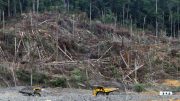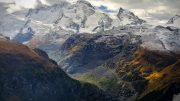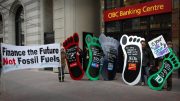 The Grapes of Wrath by John Steinbeck. Dust Bowl Ballads by Woody Guthrie. Hurricanes and floods in the Southeast. “When the Levee Breaks” written by an African American couple and interpreted by Led Zeppelin. Droughts and wildfires on the West Coast. What do they have in common? They are examples of catastrophic weather events and the artistic interpretations that reflect them.
The Grapes of Wrath by John Steinbeck. Dust Bowl Ballads by Woody Guthrie. Hurricanes and floods in the Southeast. “When the Levee Breaks” written by an African American couple and interpreted by Led Zeppelin. Droughts and wildfires on the West Coast. What do they have in common? They are examples of catastrophic weather events and the artistic interpretations that reflect them.
Whether or not all of these weather-based phenomena are caused by climate change is debatable. However, climate change increases the number of weather calamities. In the past, weather disasters frequently led to migration, and a historical examination of weather-induced migration is valuable for understanding climate migration. To put climate migration into the proper perspective it is necessary to show its global extent. A joint report from the investigative journalism organization ProPublica and the New York Times Magazine reported that “with every degree of temperature increase, roughly a billion people will be pushed outside the zone in which humans have lived for thousands of years.” This will lead to massive climate migration which is also known as climigration.
The United Nations International Organization for Migration forecasts one billion climate refugees by 2050. In 2017, researchers from Cornell University estimated 1.4 billion by 2060, and 2 billion by 2100. Abraham Lustgarten, investigative reporter from the ProPublica study on climate migration, estimated that 162 million Americans will “most likely experience a decline in the quality of their environment” in the coming years. He added that the changes could be particularly severe for 93 million. Many of these people will become climate migrants.
The ProPublica study also estimated that by 2040, 100 million Americans will face humidity so extreme that working outside or playing school sports could cause heatstroke. Because of rising sea levels, 13 million people will have to retreat from coasts.
An article in Environmental Research Letters examined the loss of housing facing the poor because of rising sea levels. The authors stated that “Residents of low-lying affordable housing, who tend to be low-income persons living in old and poor quality structures, are especially vulnerable.” Alaska is already being hit hard with rising sea levels. According to the New York Times, “The government has identified at least 31 Alaskan towns and cities at imminent risk of destruction.”
Climigration has already begun. The Internal Displacement Monitoring Centre reported that worldwide climate and weather-related disasters are displacing an average of 22.5 million people yearly. Since 2016, in the US alone, the center reported that an average of 1.2 million Americans annually had to leave their homes because of weather disasters. United States environmental history can be examined to help us understand the effect of weather disasters and climate change. Of course, not every weather disaster is caused by climate change. For example, it is debatable if the Dust Bowl of the 1930s was caused by climate change.
However, the Dust Bowl experience is relevant to climigration because it is an example of how weather disasters can lead to migration. The Dust Bowl covered more than one hundred million acres. Timothy Egan is the author of The Worst Hard Time—The Untold Story of Those Who Survived the Great American Dust Bowl. He wrote that “American meteorologists rated the Dust Bowl the number one weather event of the twentieth century … historians say it was the nation’s worst prolonged environmental disaster.” Drought, wind, and environmental errors contributed to the Dust Bowl.
Farmers had significantly changed the ecology of the plains which had been perfectly suited to the environment. Bison withstood 110 degrees Fahrenheit in the summer and 30 degrees below zero Fahrenheit in the winter. Bison were deliberately slaughtered. Instead, farmers raised cattle, which are not as appropriate for the harsh conditions of the plains. Native prairie grasses had held the soil in place and were drought resistant. Tall grasses had roots going down six feet enabling them to locate moisture. Instead of retaining bison and prairie grasses, farmers plowed the ground to raise grains to feed cattle and humans resulting in soil erosion. Thus, farmers destroyed the soil to grow corn and wheat which were not even suitable to the hot, dry environment and these crops perished during the drought.
Massive winds blew the eroded topsoil away. It is estimated that more than 80 million acres were stripped of topsoil. The harsh conditions of the Dust Bowl led 2.5 million to migrate according to an article in the journal Rural Migration News published by the University of California-Davis.
Besides increasing temperatures, climate change increases the number and severity of droughts. In California, between 2012 and 2016, an estimated 150 million trees perished during the severe drought. California’s temperature has increased by three degrees Fahrenheit. High temperatures dry out dead trees, leaves and other organic matter, providing fuel for fires. Additionally, higher fall temperatures and less rainfall lead to a 20% increase in the number of days in the fire season. Thus, the western fire season increased by at least 84 days since the 1970s. The risk for wildfires is increased by climate change-induced early melting of snowpacks. Over 70% of areas burned in forest fires between 1970 and 2012 occurred in years where the winter snows disappeared early.
Wildfires also lead to increased threats to survivor’s mental health.
Environmental epidemiologist Irva Hertz-Picciotto from the University of California-Davis studied the psychological consequences of the Tubbs Fire of 2017. She found that approximately 60% of survivors reported experiencing at least one mental health symptom, such as trouble sleeping heightened anxiety, loss of appetite or depression. Some also reported a change in their use of alcohol and drugs. About 20% experienced four or more of these symptoms because of the wildfire.

When the Levee Breaks / That Will Be Alright , record label, copyright owner Columbia Records, public domain en.wikipedia.org ,source http://rateyourmusic.com/release/single/memphis_minnie_and_kansas_joe/when_the_levee_breaks___that_will_be_alright
The 2020 wildfires burned approximately five million acres. These wildfires put around 2.5 million homes at risk. The ProPublica report stated that by 2040 at least 28 million Americans will be threatened by megafires which will also increase climigration.
Besides increasing droughts and wildfires, climate change can also dramatically increase rainfall. This frequently results in more extreme flooding. The Mississippi Flood of 1927 was probably not caused by climate change. It occurred after many months of torrential rain throughout the area surrounding both the tributaries and the river itself. This area covers more than 40% of the US and includes parts of 31 states. The area that drains into the Mississippi extends from Canada to the Gulf of Mexico and New York west to Idaho and New Mexico.
Although historians have written about it, the public is not as familiar with the Mississippi Flood of 1927 as it is with Dust Bowl. Backwater Blues—The Mississippi Flood of 1927 in the African American Imagination was written by history professor Richard M. Mizelle Jr. He wrote that the flood “was a slow-moving disaster that built up to a crescendo over time as levee after levee began to fail during the spring.” Journalist John Barry, author of Rising Tide—The Great Mississippi Flood of 1927 and How It Changed America stated that there were one million flood victims.
Professor Susan Scott Parrish, author of The Flood Year 1927, wrote that the lower Mississippi Valley flood covered 27,000 square miles in seven states, and approximately 637,000 lost their homes, of which approximately 555,000 were racial or ethnic minorities. Like the Dust Bowl tragedy, the magnitude of the damage of the Mississippi flood of 1927 was amplified by man-made environmental errors. From their first arrival, white farmers made poor decisions. Native Americans had told the first European explorers that the river flooded every fourteen years, yet they developed the vulnerable riverfront anyway.
Parrish wrote that the flood was “the product of environmental practices in the upper part of the watershed: deforestation of the upper Midwest, mowing under of prairie grasses to the west, industrial growth of corn and wheat, and drainage of wetlands. Without trees, grasses, deep roots, and wetlands, the denuded soil of the watershed could not do its ancient work of absorbing and stalling water after seasons of intense snow and rain.”
During the aftermath of the flood, Caucasians fared much better than African Americans. Whites were given refuge at indoor facilities, such as downtown department stores and hotels. They were provided both meat and a higher quality of food than blacks. Whites received new clothes first, and their children received healthcare before black children. African Americans were forced to live in outdoor camps. Mizelle wrote that in Greenville, Mississippi, “Every black family, single man, woman, and child, had to be vouched for by a local white person to receive food and shelter, without exception.” The food and shelter that they received was inadequate, and they were forced to sleep on the ground. According to Red Cross official policy, flood relief was supposed to go directly to tenants and sharecroppers and not to landlords. However, some landlords took control over the rations, and some even charged their tenants for them. Men were forced to repair broken levees and clean polluted cities.
J. Winston Harrington, investigative journalist, wrote that “Clean-up squads are now working in the white sections of the city keeping the streets and alleys in sanitary conditions, while sections of the city where our people live are used as dumping grounds for disease-breeding trash from the white sections.” One sign read “refugee labor is free to all white men.” A report from the Colored Advisory Committee detailed “fearful black tenants scared of being whipped by white planters who stole refugees’ supplies.”

Copyright by Twentieth Century-Fox-Film Corp. MCMXXXX – Scan via Heritage Auctions. Cropped from original image., Public Domain, https://commons.wikimedia.org/w/index.php?curid=86209378
Just as The Grapes of Wrath and folk ballads were written about the Dust Bowl, novelists and song writers wrote about the flood. William Faulkner wrote about it in several of his novels. He showed the relationship between the environment and the white power structure in Go Down Moses. Faulkner wrote “This land which man has deswamped and denuded and derivered in two generations so that white men can own plantations.”
The African American author, Richard Wright, wrote two short flood stories. Many blues songs were written about the flood, including “Back Water Blues” by Bessie Smith. The original version of “When the Levee Breaks” was written by Kansas Joe and Memphis Minnie. Other blues songs about the flood include “Greenville Levee Blues,” “Broken Levee Blues,” and “The Flood Blues.” The Mississippi Flood was a catastrophe for African Americans. Unlike the literary heritage from the Dust Bowl, the only mainstream cultural remnant of the flood is “When the Levee Breaks” by Led Zeppelin, and how many listeners know the origin of the song?
The flood did not just affect the South. Many African Americans migrated to such cities as New York, and Detroit. Almost half ended up in Chicago, which is ironic as Chicago might have contributed to the disaster.
According to journalist Ron Grossman, the Chicago Tribune reported that a Toronto meteorologist stated that if water from Lake Michigan had not been diverted through the Chicago Drainage Canal to the Mississippi, the “toll of life and property would have been very much less severe.”
Climate change will also strengthen the destructive power of hurricanes. Warmer ocean water temperatures increase both the number and intensity of them. The Clausius-Clapeyron equation shows that for every single degree Celsius (1.8 degrees Fahrenheit) of warming, the atmosphere can hold 7% more moisture. This increased moisture leads to exponentially more destructive storms. Even though Hurricane Katrina may not have been caused by climate change, it is an example of how hurricanes damage the environment and survivors. It wreaked havoc on 55,600 square miles along the Gulf Coast and left than one million residents homeless. Hurricane Karina particularly battered the poor and racial minorities, especially children.
Lori Peck, a sociologist at the Center for Disaster and Risk Analysis at Colorado State University, found that poorer children were more likely to be exposed to Katrina’s floodwaters. This led to “challenges concentrating in schools, higher anxiety levels, and more behavioral problems.”
Researchers at the National Center for Disaster Preparedness, part of the Mailman School of Public Health at Columbia University, found that evacuated children were more than four times more likely than the average child to show symptoms of serious emotional disturbance. To fully understand the suffering caused by climate change-induced weather disasters is almost impossible.
Survivors mourn all that they lost including friends and loved ones. Lifelong places of worship and graveyards of loved ones may be destroyed and gone forever. Survivors will no longer be able to cherish lost or ruined family heirlooms and a lifetime collection of mementos. Members of racial minorities and the poor have added burdens as they are always hit particularly hard, and they have fewer financial resources to help them rebuild their lives.
Thus, climate migrators lose almost everything and then have to build a new life in a new location. Family members and friends may never be seen again. Many relocators face discrimination and prejudice.
Both their physical and mental health suffer. Also, the receiving communities face providing for new students, housing, health services, and employment. Fortunately, being cognizant of all these consequences and ramifications can spur us on to work harder to slow down climate change and lesson the need for climate migration.
Lenore Hitchler





